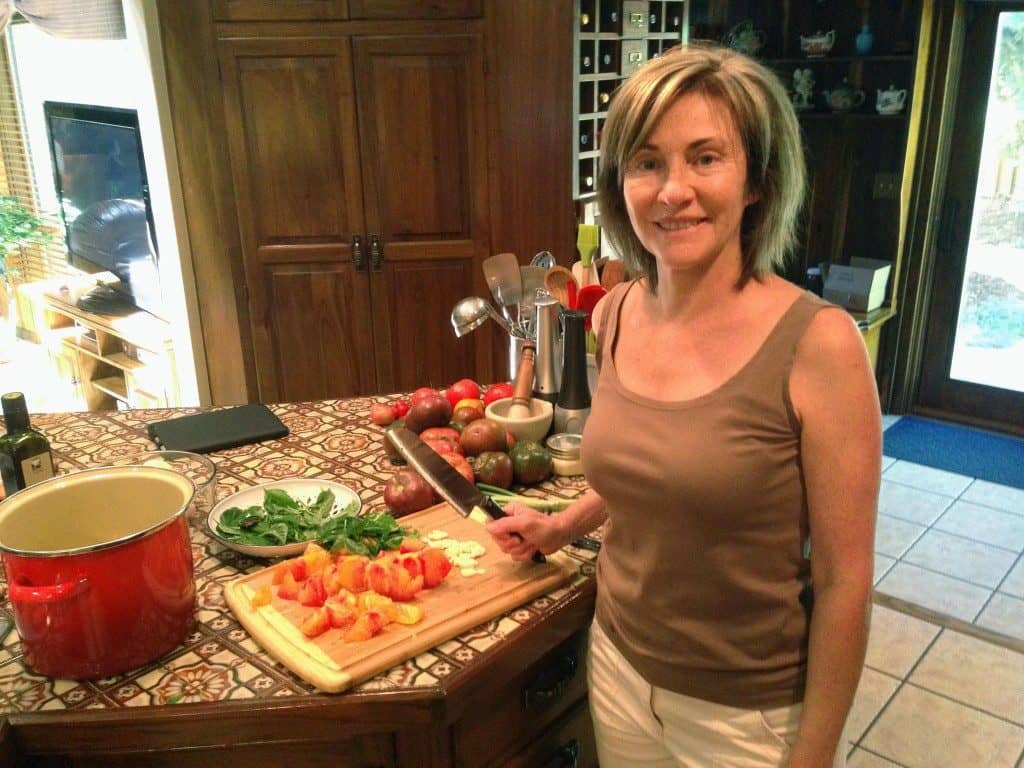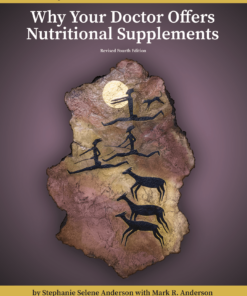My fresh, organic garden tomatoes, onions, and garlic simmer away on this early September afternoon, evoking the smells and flavors of my first autumn in northern Italy as a 6-year-old. My maternal grandparents lived on the farm where my mom grew up in the 1920s and ’30s. In the mountains of Piedmont, less than an hour from the Swiss Alps, my grandmother Dallacqua’s wine was known far and wide. To celebrate our visit, she produced a dusty bottle from the cellar. My younger brother, Wally, and I were allowed a taste. We’d had wine before, but as young as we were, we knew this was different.
The first time we climbed up to Grandma’s hilltop vineyard and orchard was the first time I tasted a persimmon. Though they weren’t yet ripe, I insisted on a bite anyway. For being so stubborn, Mom let me reap my karmic reward. An unripe persimmon makes your mouth (and, at six years old, your whole body) pucker to the point of gagging. Hence the saying, “Gag me with an unripe persimmon.” Never heard that one? Yeah, well it was “all over the Internet” in 1958.
Afterwards, my sweet mama plucked for me a fig. A single bite sent me scrambling up the fig tree for more, and I refused to come down until I had stuffed myself silly. Never had I tasted anything so deliriously good.
Temporarily sprung from our Long Island quarter acre of chemical-green lawn, Wally and I ran, laughed, and got dirty. My mother, surrounded by family, relaxed–even to the point of drinking wine during the day! Because we weren’t on her radar as much, we were free to make our own adventures. My brother and I couldn’t wait for morning to gather eggs in the barn, with chickens running underfoot. All of the animals lived under one clay tile roof, and the smell of sweet hay and rabbit poop is still something I can’t get enough of. One afternoon while the adults had their siesta, I led my little brother into the hills, carrying a long pole just as my grandma did when she led us on hikes. When we got back, everyone was frantic. My mother was frantic and hysterical. Hot Italian tempers flamed us to a crisp. Later, when everyone finally accepted the fact that we had not, in fact, been eaten by wild boar, they calmed down and cheered up. Mom said she was grateful that I had at least brought the pole with me.
“Why?” I asked.
“What do you mean, why? Because that’s what you use to kill snakes! What did you think it was for?”
I had no idea—I was simply imitating my grandmother, the leader of the pack.
This trip was an event in my life that has never stopped bringing me joy and knowledge, an experience that strengthened my connection to life. But, hold on a minute while I stir my sauce—a simple, quick affair meant to just flash freeze the fresh flavors of the garden. For this impatient Italian’s sauce, I chop the tomatoes (no peeling or seeding necessary), peel and crush the garlic, cut the onions into chunks, and wash the freshly picked basil. Into a pot, I pour olive oil. When that’s heated, I add the crushed garlic, stir for a minute or two, and throw in the onions. As they cook, I stir them occasionally, until they soften. Finally, the tomatoes go in and I stir it all together and I stir it often, so the ingredients don’t burn on the bottom of the pot. Once the sauce comes to a strong boil, I turn the heat down to let it simmer and cook off the liquid. Earlier in summer, when our tomatoes start coming in, I’ll make a super quick small batch of this sauce in the morning to serve with breakfast. But today has brought a big harvest of tomatoes, onions, garlic, and basil. I’ll need just a little longer before I can add the red wine (to sweeten it a bit), salt, and chopped basil. The basil is cooked for only a minute or two, as fresh herbs will lose their flavor if cooked for too long. As soon as I think the basil has had enough time, I pull the pot off the fire and leave it to cool for several hours.
The idea for this quick sauce came from my Grandpa Dallacqua. He spent several years separated from his wife and children when World War II broke out, an exile in New York City who worked as a chef at the Waldorf Astoria. When I was 21, I went back to Italy to visit my grandparents again. By then, they had left the farm for a condo in town. On our first morning, Grandpa left early to shop for fresh ingredients. As lunchtime approached, I watched him in the kitchen, heating a saucepan. He prepared this delicious sauce in no time, and in all the time since I’ve never forgotten the deft and graceful movements of his hands. The idea of preparing something so delicious in so short a period of time also appealed to my perpetual state of hunger. I replay his steps from memory: chop the tomatoes, throw them into a hot saucepan already sizzling with garlic and onions, cook it down. Add a splash of red wine, fresh basil, and salt. Serve with grated Parmesan, pasta, meat, fish, gnocchi, Arborio rice, or all of the above—as could easily happen, and often did, at the lavish feast my relatives called “lunch.”
Time to stir and taste my sauce again. It’s beginning to get that great concentrated tomato flavor and the liquid has almost cooked off enough. I’ll finely chop the basil so it’s ready to add to the pot. You know, to be fair, my 21-year-old self might have overlooked the fact that Grandpa did peel and seed his tomatoes. I have nothing against that. It is more refined. And, perhaps, correct. If you don’t like the feel of tomato skin or seeds in your sauce, you’ll have to add those steps. Seeding the tomato also removes more liquid and will cut down the cooking time. Here’s a short video on both. I like it because it makes the peeling method look easy and doesn’t remove as much of the tomato as other seeding methods I’ve seen. But you may want to check out other sources as well, depending on your recipe.
We made a thicker style of sauce at our home in New York on Sunday mornings. It would cook for several hours. Mom would get it started early by browning ground pork (or sometimes sausage), ground lamb, and beef. She’d set the meat and juices aside to add later to the tomato sauce and then let it all simmer on the stovetop until we left for Sunday mass. Because it was winter, she used canned tomatoes and tomato paste, dried Italian herbs, and a sprinkling of red pepper flakes.
In those days, Catholics fasted all morning before receiving Holy Communion. With a rumbling stomach, I complained heartily of starvation. Every now and then, Mom would break the rules and dunk a chunk of Italian bread into the sauce and apply it to my hungry mouth like a pre-communion rite.
Another of our rites began after my grandparents moved from New York to retire to their farm in Italy. Packages wrapped in brown paper and tied with string arrived a few times a year. My favorites were the dried chamomile flowers, dried chestnuts, and dried wild mushrooms. Grandma once sent me white leather shoes handmade by a local cobbler. They were wrapped in the same box as the dried mushrooms. The smell of pure leather and musky truffles forever braided into my synapses.
Now, back to my sauce. It’s ready for the final steps. A glug—okay two glugs of red wine. Let that bubble a bit until it takes the edge off the tart tomato acid and the alcohol cooks off. Now some sea salt, a few stirs, a taste. Perfect. Time for the basil.
Now that I think about it, it was common in my family for both the men and the women to share food duties. My grandfather cooked more often than my grandmother, but at home, my mom cooked more often than my dad. My dad and uncles hunted for food. But it was Mom who hung the dead rabbits and pheasants from the basement ceiling and gutted, skinned, and cleaned them. And it was Dad who planted an organic garden every summer. In Italy, my grandmother did the planting. During that trip when I was 21, Wally and I followed my uncles and grandparents as they scoured the forest for wild mushrooms. My uncle Giovanni chased the chickens until he caught one for supper. We were treated to a view of the beheading, the hot-water bath that followed, and finally the swift plucking of the bird before it was delivered into Grandma’s hands. Then it hit the chopping block for a second time to be separated into parts. They used everything from the chicken—blood, feet, heads. Everything.
Together, the men and women gathered, hunted, prepared, and cooked food. To this day, my brother does the same. Though my son, working his first job out of college in San Francisco, has little occasion to grow or hunt his food, he does hunt down the best sources he can find of fresh, local, organic fare. Then he cooks it himself. It’s great to know that my son is out there in the junk- and fast-food wilderness not just surviving, but thriving.
Mammas, don’t let your cowboys and ballerinas grow up to be stupid in the kitchen. If you want your kids to be healthy for life, make sure they see you—and help you—plant, grow, harvest, and prepare food. Make sure they smell it cooking. Confidence in the kitchen is an essential survival skill. Failing that, make sure they marry chefs.
Food is a relationship with life. If that relationship consists of a series of drive-by grabbed bags of fast food to eat on your way to your next meeting or soccer game, the chances are high that your kids will grow up to reflect the same kind of relationship in their own lives. If your relationship with food includes frog’s legs, tripe, snails, and Gorgonzola cheese, the chances are equally high that your kids will absorb a wide range of colorful culinary options for when hunger strikes. They won’t be satisfied slurping a giant blue sugar pacifier. They will want nourishment, and they’ll know where to find it.




